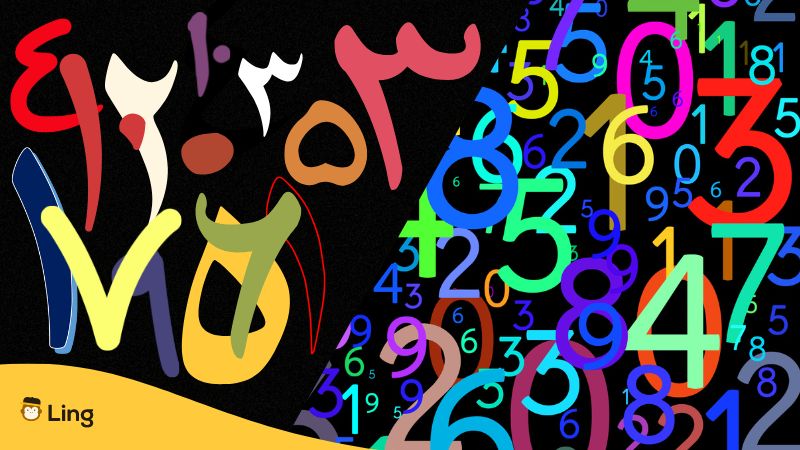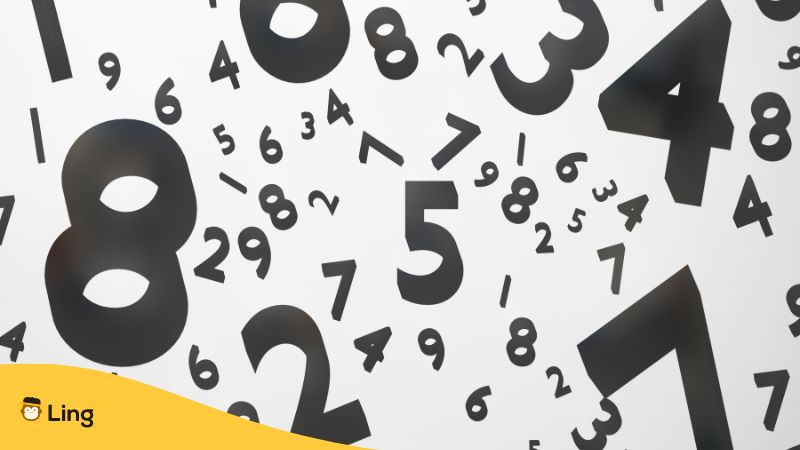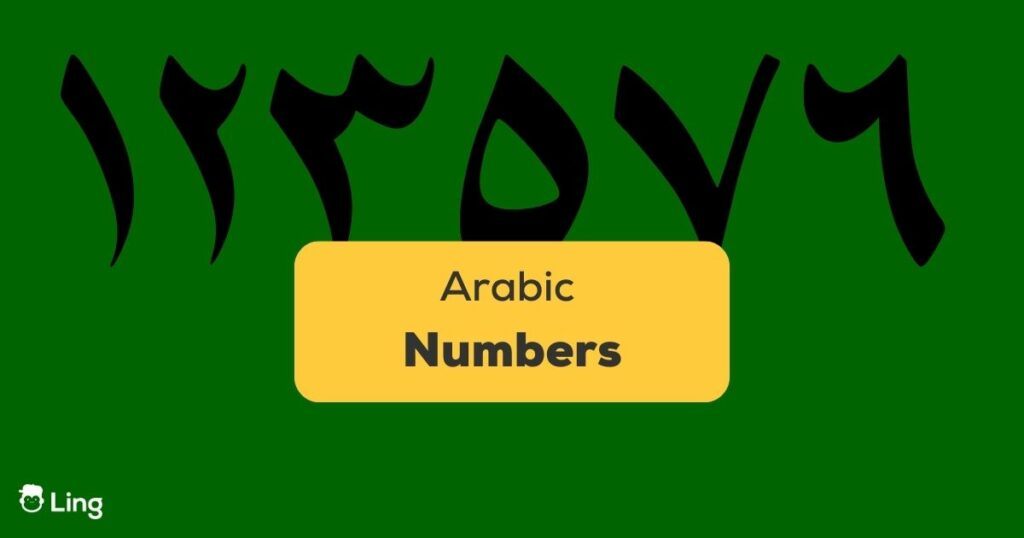Learning Arabic numbers is an essential step in understanding the Arabic language. One reason is that it’s practical to have this memorized when planning to visit an Arab-speaking country to work alongside native speakers. In that case, knowing how to count in Arabic is essential for everyday communication and practical tasks. In today’s post, we’ll go over this to help you confidently express yourself when doing practical tasks, such as shopping, telling time, and making phone calls.
Arabic numbers are unique in several ways. For one, they are written and read differently than numbers in the Western Arabic numeral system used in many parts of the world. Arabic numbers are written and read in an RTL (right-to-left) fashion directionality. On the other hand, numbers are read left-to-right (LTR)! In addition, they make use of unique symbols to represent their numbers.
Arabic Numbers
Arabic speakers have a name for each of the digits, which come from the Arabic words for ‘one,’ ‘two,’ and so on up to ‘nine.’ Learning the individual names of the digits is essential in understanding how to read and write Arabic numbers.
The use of Arabic numbers dates back to the fourth century. They first appeared in Arabic texts from what is now Iraq and were subsequently used by Arabic-speaking mathematicians in the eighth century. The earliest surviving examples of written documents that used Arabic numerals can be found in records from the ninth century.
At the time, Arabic numerals were a breakthrough in number systems as they were more efficient and accurate than previous counting methods. This allowed for more accurate calculations and accounting. They were quickly adopted by other cultures and languages, which helped them spread around the world.
Today, Arabic numbers are used for various purposes, from counting to recording data to measuring distances. In addition, Arabic numerals are often used as abbreviations for Arabic words such as “Quran” or “Inshallah.”
How Are Arabic Numbers Used Today?
For Arabic speakers, the use of Arabic numbers is essential. They are used in writing and many different contexts when reading or speaking in Arabic. In fact, some Arabic texts may only be readable if written using the correct form of Arabic numerals. Furthermore, it is common for Arabic speakers to use a combination of words and numbers to represent figures – such as the word ‘١٠٠’ meaning 100 – which adds to the need for learning and understanding Arabic numerals.
In addition, a basic understanding of Arabic numerals can help when communicating in other languages, such as French and Spanish. This means recognizing and understanding Arabic numerals can have far-reaching benefits, opening up new opportunities in many different contexts.
Eastern VS Western Arabic Numerals

Eastern and Western Arabic numerals are slightly different, each originating in another region and having unique characteristics. Let’s explore the fascinating difference between Eastern and Western Arabic numerals and how they have evolved.
Differences
Eastern Arabic numerals are a set of digits used primarily in the Middle East, North Africa, and Central Asia. They are written from left to right and start with a curved shape at the top. On the contrary, Western Arabic numerals are the most common digits used today, and they are derived from the Hindu-Arabic numeral system, which originated in India. They are written from left to right, starting with a straight line at the top.
The symbols used in Eastern Arabic numerals/Hindu Arabic numerals differ from those used in Western numerals. In Eastern Arabic numerals, the signs for 0, 1, 2, 3, 4, 5, 6, 7, 8, and 9 are,””٠”, “١”, “٢”, “٣”, “٤”, “٥”, “٦”, “٧”, “٨”, and “٩” respectively. Whereas in Western Arabic numerals, the symbols for these numbers are the same, i.e., 0, 1, 2, 3, 4, 5, 6, 7, 8, and 9, respectively.
The way Eastern and Western Arabic numerals are written is also different. For example, when writing large numbers in Eastern Arabic numerals, commas are placed between every three digits starting from the right. In Western Arabic numerals, the commas are placed between every three digits starting from the left.
Regarding usage, Eastern Arabic numerals are primarily used in handwritten texts or documents, while Western Arabic numerals are predominantly utilized in printed copies or digitally displayed text.
Why The Change?
Firstly, trade between East and West increased significantly during the transition, and merchants needed a way to communicate quickly and efficiently. This may explain why the West adopted a system that allowed for easy reading of numbers.
Secondly, Europe had a long-standing tradition of using Roman numerals and may have felt more comfortable continuing to use them.
Lastly, as Islamic countries began to take control of parts of Europe, they also brought the numbering system, which became more commonplace.
Overall, the transition from Eastern to Western Arabic numerals was motivated by cultural exchange, practicality, and convenience. This resulted in the widespread acceptance of Arabic numerals and their continued use in many parts of the world today.
Ordinal Numbers
| English Number | Arabic | Romanization |
| One | واحد | Wahid |
| Two | اثنين | Aithnayn |
| Three | ثلاثة | Thalatha |
| Four | أربعة | Arbaea |
| Five | خمسة | Khamsa |
| Six | ستة | Sita |
| Seven | سبعة | Sabea |
| Eight | ثمانية | Thamania |
| Nine | تسع | Tise |
| Ten | عشرة | Eashra |
| Eleven | أحد عشر | Ahad Eashar |
| Twelve | اثني عشر | Aithnay Eashar |
| Thirteen | ثلاثة عشر | Thalathat Eashar |
| Fourteen | أربعة عشرة | Arbaeat Eashra |
| Fifteen | خمسة عشر | Khamsat Eashar |
| Sixteen | السادس عشر | Alsaadis Eashar |
| Seventeen | سبعة عشر | Sabeat Eashar |
| Eighteen | الثامنة عشر | Althaaminat Eashar |
| Nineteen | تسعة عشر | Tiseat Eashar |
| Twenty | عشرين | Eishrin |
| Twenty-One | واحد وعشرين | Wahid Waeishrin |
| Twenty-Two | إثنان وعشرون | Iithnan Waeishrun |
| Twenty-Three | ثلاثة وعشرون | Thalathat Waeishrun |
| Twenty-Four | اربع وعشرون | Airbae Waeishrun |
| Twenty-Five | خمسة وعشرين | Khamsat Waeishrin |
| Twenty-Six | ستة وعشرون | Sitat Waeishrun |
| Twenty-Seven | سبعه وعشرين | Sabeuh Waeishrin |
| Twenty-Eight | ثمانية وعشرون | Thamaniat Waeishrun |
| Twenty-Nine | تسعة وعشرون | Tiseat Waeishrun |
| Thirty | ثلاثون | Thalathwun |
| Thirty-One | واحد وثلاثين | Wahid Wathalathin |
| Thirty-Two | اثنان و ثلاثون | Aithnan W Thalathwun |
| Thirty-Three | ثلاثة وثلاثين | Thalathat Wathalathin |
| Thirty-Four | اربع وثلاثون | Arbae Wathalathun |
| Thirty-Five | خمسة وثلاثون | Khamsat Wathalathun |
| Thirty-Six | ستة وثلاثون | Sitat Wathalathun |
| Thirty-Seven | سبعة وثلاثون | Sabeat Wathalathun |
| Thirty-Eight | ثمانية و ثلاثون | Thamaniat W Thalathwun |
| Thirty-Nine | تسعة وثلاثون | Tiseat Wathalathun |
| Forty | أربعين | Arbaeyn |
| Fifty | خمسون | Khamswun |
| Sixty | ستون | Sittwun |
| Seventy | سبعون | Sabewun |
| Eighty | ثمانون | Thamanwun |
| Ninety | تسعين | Tisein |
| Hundred | مائة | Miaya |
| Thousand | ألف | Alf |
| One Million | مليون واحد | Milyun Wahid |
| One Billion | مليار واحد | Milyar Wahid |
| One Trillion | ترليون واحد | Tirilyun Wahid |

Cardinal Numbers
| English Number | Arabic | Romanization |
| First | أولاً | Awlaan |
| Second | ثانية | Thania |
| Third | ثالث | Thalith |
| Fourth | الرابعة | Alraabiea |
| Fifth | الخامس | Alkhamis |
| Sixth | السادس | Alsaadis |
| Seventh | سابعا | Sabiean |
| Eighth | ثامن | Thamin |
| Ninth | تاسع | Tasie |
| Tenth | العاشر | Aleashir |
| Eleventh | الحاديه عشر | Alhadih Eashar |
| Twelveth | الثاني عشر | Althaani Eashar |
| Thirteenth | الثالث عشر | Althaalith Eashar |
| Fourteenth | الرابع عشر | Alraabie Eashar |
| Fifteenth | الخامس عشر | Alkhamis Eashar |
| Sixteenth | السادس عشر | Alsaadis Eashar |
| Seventeenth | السابع عشر | Alsaabie Eashar |
| Eighteenth | الثامن عشر | Althaamin Eashar |
| Nineteenth | التاسع عشر | Altaasie Eashar |
| Twentieth | عشرين | Eishrin |
Wrapping Up

Are you looking to learn a new language but need help knowing where to start? Look no further! The Ling app is a revolutionary app that allows you to learn a new language in a fun and interactive way. From its interactive lessons to its comprehensive library of language resources, the Ling app can help you master the language of your choice in no time.
Want to try it out? You can start your language learning journey with Ling today on iOS or Android.



































































